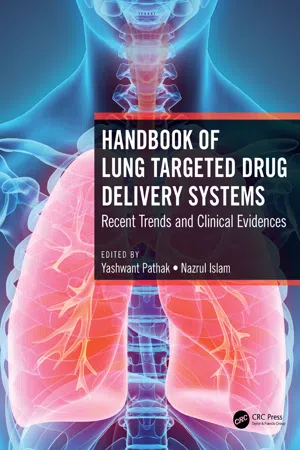1.1.1 Brief Introduction to Nanotechnology and Nanoparticle Mediated Drug Delivery
Nanoparticles (NPs) are nanosized materials used to embed drugs, imaging agents and genes intended for targeted drug delivery by covalent conjugation or noncovalent attachment (1). As defined by the International Organization for Standardization, NPs are those having at least one dimension less than 100 nm. The American Food and Drug Administration (FDA) has cited another broader definition of NPs as ‘engineered to exhibit properties or phenomena attributable to dimensions up to 1000 nm’, which is typically adopted in academic research (2). To deliver the appropriate amount of the desired drug precisely to the target organ without causing any side effects while also taking care of the induction of drug resistance is a daunting task; however, it is an important requirement in a targeted drug delivery system (DDS) (3). NP drug carriers can modulate drug distribution via passive and active targeting. Passive targeting is the process by which nanoscaled particles accumulate in tumors/sites of inflammation merely due to their size, whereas active targeting works through the attachment of biochemical moieties which facilitate delivery to diseased tissues expressing biomarkers distinguishing them from the surrounding healthy tissue (4). The term nanotechnology involves manipulating and controlling nanoscale (1–100 nm) objects. For over 28 years, the potential benefit of nanotechnology has been appreciated by most researchers and has revolutionized the field of drug delivery and drug targeting with the hope of transforming Ehrlich's hypothetical concept of a “magic bullet” into clinical reality.
The new interdisciplinary platform of nanotechnology-based DDS shows a great deal of promise with several advantages such as improved solubility and bioavailability of hydrophobic drugs, rendering them suitable for parenteral administration encapsulation efficacy which enhances the drug release profiles, high drug payload, extended drug half-life, improved therapeutic index of peptides, oligonucleotides, etc., controlled release along with reduced immunogenicity, and toxicity (5). They can further be used for drug delivery to the central nervous system (CNS) owing to their smaller size and higher barrier permeability.
1.1.2 The Inhalation Route
Drug delivery via the inhalation route has been known since the distant past, when the Egyptians inhaled black henbane vapour to treat various diseases (6). The lung is taken into high consideration as an attractive target among a myriad of routes of administration due to its several advantages (2) over conventional oral administration. Drug delivery to the lungs by inhalation offers a targeted drug therapy for a wide range of respiratory diseases including lung cancer, chronic obstructive pulmonary disease (COPD), asthma, cystic fibrosis (CF), tuberculosis (TB), pneumonia and pulmonary hypertension (7), among which COPD, lower respiratory infections and lung cancer are the third, fourth and sixth causes of death worldwide respectively. Other than pulmonary disease, inhaled medications are also beneficial for treatment of anxiety, hypertensive crisis, certain seizures, arrhythmias, spasms, nausea and myriad forms of pain (8).
The inhalation route has received widespread attention within the drug delivery field as it possesses many characteristics ideal for drug transportation and has many advantages over other methods, since the lungs have a large surface area (100 m²) and a very thin epithelial layer (0·2–0·7 μm) for high blood perfusion, elevated blood flow (5 L/min), extensive vascularization to promote systemic delivery, high solute permeability, avoidance of first pass metabolism, and sustained release of the drug and thus reduced dosing frequency (9, 10, 11). In addition, drug-metabolizing enzymes are present in much lower concentrations in the lungs than the gastrointestinal tract and liver, thereby limiting enzymatic and proteolytic interaction with the inhaled molecules (8). Moreover, the lung is capable of absorbing pharmaceuticals either for local deposition or for systemic delivery by targeting the drug delivery carriers to the alveolar region with uniform distribution. Additionally, in inhalation drug delivery there is no risk of needle injuries and health-care staff are not needed, resulting in better patient compliance. The pulmonary tissue has notably high levels of systemic bioavailability for macromolecules, making it the best non-invasive absorption route. Although drug molecules are absorbed more efficiently from the lung than from any other non-invasive routes, however, the therapeutic efficacy of inhaled drugs is limited by their rapid clearance in the lungs (12).
The practice of respiratory medicine has entered into a brave new era through the development of new therapeutic strategies and improvement of current therapies, with some NPs already developed into commercial products. Although inhalation devices and aerosols containing various drugs have been used since the early 19th century, currently there are three main delivery devices used for pulmonary delivery of drugs, viz. nebulizers, pressurized metered-dose inhalers and dry powder inhalers (DPIs) to deliver solutions, suspensions and dry particles respectively (13, 14) and an array of carrier systems, which hold great potential for treating diseases that require direct lung delivery. An ideal delivery device has to generate an aerosol in the range of 0.5–5 µm and provide reproducible drug dosing without affecting the physical and chemical stability of the drug formulation (15). Moreover, the ideal inhalation system must be a simple, convenient, inexpensive and portable device. Although efficient and reproducible pulmonary deposition of aerosol medicines is now possible with current technology, however, the mechanism of the action of particles after pulmonary deposition is highly complex due to the various barriers and clearance mechanisms in the respiratory tract, which pose significant challenges in formulation development (6). The fate of particle–lung interactions are still being researched and have become indispensable for pharmaceutical scientists to develop more effective inhalable formulations. Moreover, toxicity and regulatory concerns limit approval of nanotechnology-based medicinal products (16).
The primary focus of this chapter is to provide an insight into the physiological and efficacy aspects of the mechanism of pulmonary DDS with respect to the lung structure and characteristics, and also the research progress on various parameters to be considered during formulation development and how molecular properties affect rate and extent of pulmonary drug absorption, clearance and metabolic mechanisms, etc. Herein, we have also highlighted the future opportunities for nanotechnology focusing on the treatment of lung diseases.
